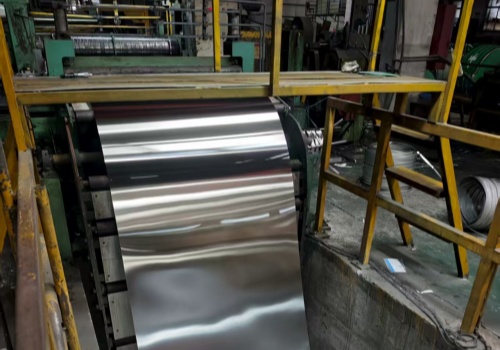What Is 410 Stainless Steel?
In the international stainless steel material market, 410 stainless steel, as one of the most fundamental martensitic stainless steels, has become the preferred material in many industrial fields due to its excellent mechanical properties, good corrosion resistance and high cost performance. This article will comprehensively analyze the chemical composition, core characteristics and wide applications of 410 stainless steel, providing you with a reference for professional material selection.
Chemical Composition And Physical Properties
Chemical Composition:
Chromium, as the core alloying element, provides basic corrosion resistance. The carbon content is controlled within a reasonable range, which not only ensures high hardness after heat treatment but also avoids excessive carbon content from damaging the weldability and corrosion resistance of the material. This composition design makes 410 stainless steel a balanced work of strength, corrosion resistance and workability.
|
Element |
Content(%) |
Element |
Content(%) |
|
C |
≤0.15 |
Si |
≤1.00 |
|
Cr |
11.50-13.50 |
Mn |
≤1.00 |
|
P |
≤0.040 |
S |
≤0.030 |
|
Ni |
≤0.75 |
Fe |
most |
Physical Properties:
- Density : 7.70-7.75 g/cm³
- Melting point:1480-1530°C
- Thermal conductivity: 24.9 W/(m·K)(100°C)
- Coefficient of thermal expansion: 9.9-10.3 μm/m·K(20-100°C)
- Magnetic: It is magnetic in all states
The Advantages Of Core Perfermance
1.Outstanding mechanical properties
- 410 stainless steel can achieve a wide range of mechanical properties through heat treatment:
- Annealed state: Tensile strength ≥440 MPa, yield strength ≥205 MPa, elongation ≥20%
- After quenching and tempering: The tensile strength can reach 600-1300 MPa, and the hardness can reach 30-40 HRC
|
TT ℃) |
0.2%YS(MPa) |
TS(MPa) |
EL(%) |
HB |
|
260 |
1089 |
1331 |
17 |
401 |
|
317 |
1069 |
1296 |
17 |
401 |
|
482 |
1014 |
1303 |
18 |
401 |
2.Good corrosion resistance
- Resistant to atmospheric corrosion, fresh water and food acid
- Performs well in low concentration chloride solution, nitric acid and weak alkaline environment
- 410 stainless steel protects the surface from further corrosion by forming a dense oxide film, but its corrosion resistance is limited in high concentration chloride environment or strong acid (such as hydrochloric acid, sulfuric acid) conditions.
3.Excellent processing and heat treatment performance
- Machining performance: Surface processing speed in annealed state can reach 18.3-24.4 m/min
- Cold forming capability: Moderate cold forming can be performed in annealed state
- Hot forming performance: Hot working is recommended in the temperature range of 750-1150°C
Main Applications Of 410 Stainless Steel
1. Industrial equipment and mechanical manufacturing
- Valve assembly: Wear-resistant parts such as valve seats and valve covers
- Bearings and shaft systems: Mechanical components that require high strength and wear resistance
- Pump components: Impellers, pump casings and other fluid handling components with moderate corrosion resistance requirements
- Fasteners: Bolts, nuts and other high-strength connecting parts
2. Energy and chemical engineering fields
- Turbomachinery: steam/gas turbine blades and moving blades
- Nuclear reactor components: Control rod mechanism
- Petrochemical equipment: Reactors, pipe fittings and other components resistant to nitric acid corrosion
- Denitration system: Denitration devices and condensers resistant to nitric acid corrosion
3. Tools and daily necessities
- Cutting tools: Industrial cutting tools, kitchen cutting tools
- Tableware category: 1 type of tableware such as spoons, forks, and knives
- Surgical instruments: Medical forceps, scissors and other sterilized instruments
The Unique Advantages Of 410 Stainless Steel
- Cost-effectiveness: more affordable than 300 series stainless steel
- Adjustable strength range: a wide range of mechanical properties can be obtained through heat treatment
- Processing convenience: excellent machinability and formability reduce manufacturing costs
- Versatility: balance corrosion resistance, strength and manufacturability
Conclusion
410 stainless steel achieves an ideal balance of strength, corrosion resistance and processability with its optimized chemical composition design and flexible heat treatment process. It has good formability in the annealed state and can obtain high strength and hardness after heat treatment. It is suitable for a variety of working conditions that require both structural strength and moderate corrosion resistance.
In the fields of chemical equipment, machinery manufacturing, energy equipment and daily tools, 410 stainless steel has demonstrated excellent economy and reliability. Its globally unified grade standard and widely recognized material properties make it one of the most popular stainless steel materials in international procurement.
Contact
Phone: +86 189 2312 5835 (WhatsApp/Wechat)
Email: info@fsx-metal.com.cn
